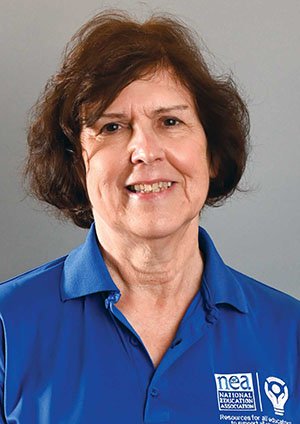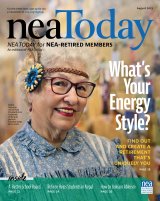About 20 years ago, while Mary Binegar was teaching in Urbana City Schools, in Ohio, she was in a serious car accident that left her with two broken legs and a broken bone in her shoulder.
“I spent 18 months in a wheelchair, and I became very aware of the many challenges people with disabilities face that aren’t always obvious to the rest of us,” she says.

Binegar, who retired 10 years ago, recalls that to get to her classroom, she had to have a colleague open a back door so she could take a circuitous route through an auditorium to her hallway. And there was no access to the cafeteria, office, or most of the rest of the school.
She experienced challenges outside of school, too, such as ramps that were too steep to navigate without help and an “accessible” fourth-floor hotel room, with no way to escape if the elevator wasn’t working in an emergency.
“At that hotel, they followed the letter of the law, but didn’t think about what would happen in a fire or other emergency—the actual needs of a person in a wheelchair,” she explains.
Quote by—Mary Binegar, retired special education teacher, in Ohio
Educators are raising awareness

Binegar and Maxine Mosley—a retired school counselor from Manchester, N.H.—both worked with students with special needs—with both physical and learning disabilities—who often faced ableism. The pair are also members of NEA’s IDEA (Individuals with Disabilities Act) Resource Cadre, a highly experienced and diverse group of educators who collaborate with local and state NEA affiliates as well as national partners to address inequities facing students with disabilities.
To expand on these efforts, NEA has also launched an initiative, in partnership with the Ford Foundation’s U.S. Disability Rights Program, which aims to raise awareness and eliminate discrimination toward individuals with disabilities.
“Ableism, much like ageism, is a discriminatory stereotype. Ageism frames ‘older people’ as being less capable, less independent, and in need of assistance as compared with younger persons,” says Melissa Mayville, an NEA senior policy analyst.
Much like ageism, she says, ableism is rooted in the assumption that those with disabilities need help or need to be “fixed,” and perceptions that those with disabilities “are less-than or incapable as compared with non-disabled persons.”
Ableism is everywhere
Ableism sometimes involves open discrimination, such as segregating disabled students or discounting a job applicant because of a former mental health issue, the educators explain.
But more often, it is subtle or unintended, for example, “helping” to push a person in a wheelchair without permission, petting a service dog without asking, or taking a designated parking space.
Ageism can also be an impatient sigh or horn honk when a senior citizen or person with a disability needs extra time in a checkout line or doesn’t drive off quickly when the traffic light changes.
And while many older adults experience hearing loss, family members and strangers alike may become frustrated with them.
Often, Binegar says, correcting discriminatory behavior can be as simple as asking what works best for someone.
This can mean inquiring if a person wants help crossing the street or including people with disabilities in discussions about how to make buildings more accessible.
“It’s just about being mindful of what we say and do,” she says. “It’s just about stopping to think.”
20 percent of the population has a disability. After age 65, that number jumps to 40 percent.
SOURCE: CENTERS FOR DISEASE CONTROL AND PREVENTION
Use sensitive language.
Be aware of unintended ‘microaggressions.’
Don’t be dismissive.
Learn More








